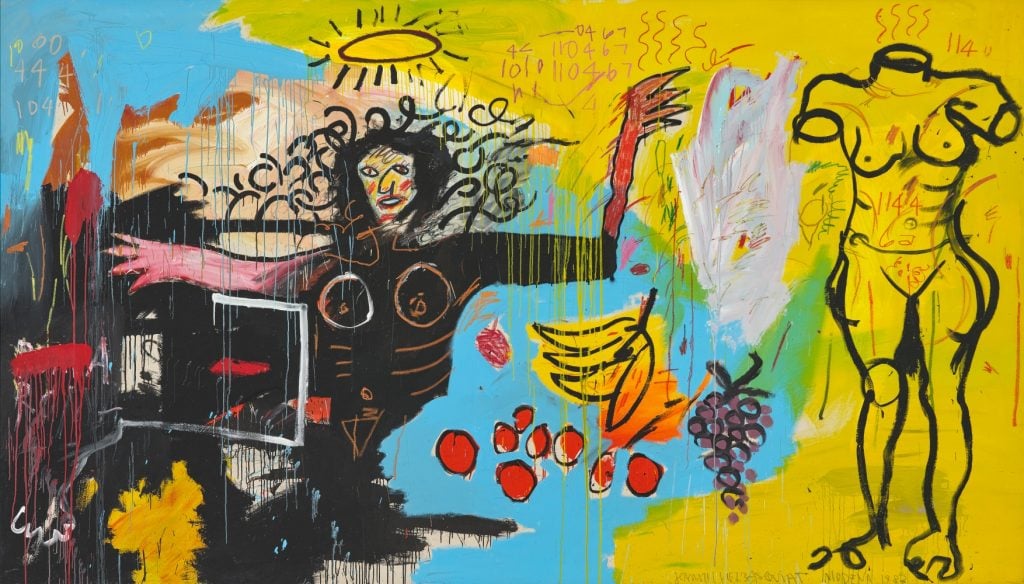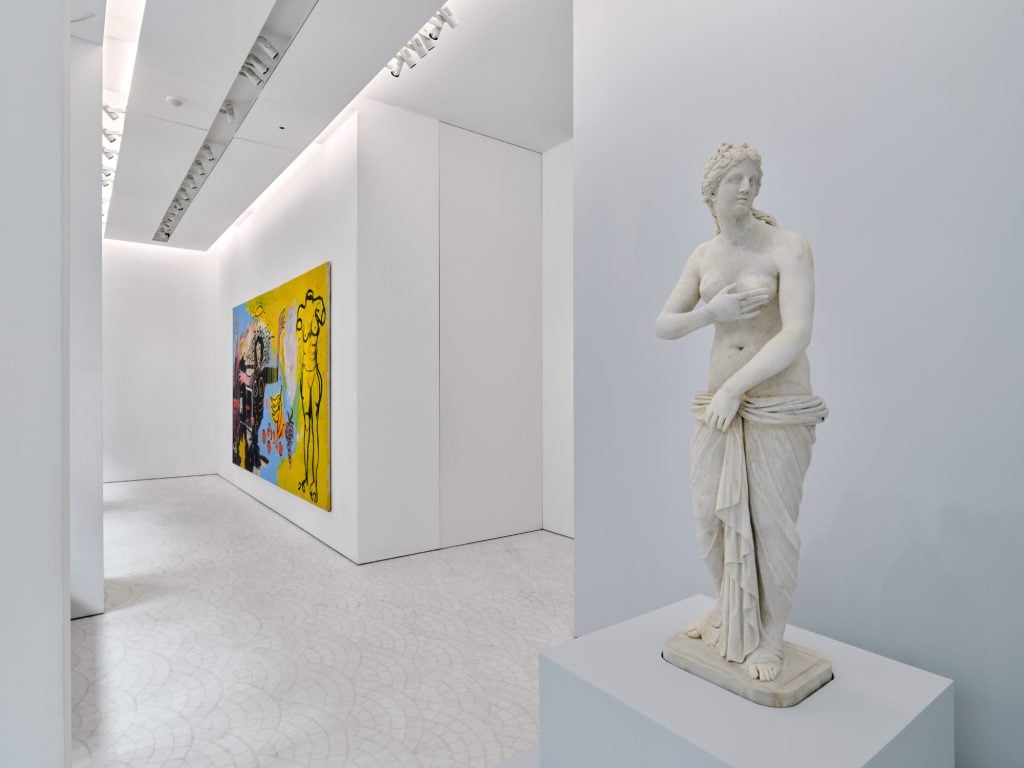On View
Jean-Michel Basquiat Meets a Roman Venus at Gagosian Paris
Basquiat "reminds us of the common chords and resonances of beauty and identity throughout art history," said Larry Gagosian.

Basquiat "reminds us of the common chords and resonances of beauty and identity throughout art history," said Larry Gagosian.

Jo Lawson-Tancred

In a rare meeting between the classical and the contemporary, Gagosian’s Paris gallery has staged a show pairing an ancient Roman sculpture with work by Jean-Michel Basquiat. The sculpture of the goddess Venus juxtaposed with Basquiat’s 1982 painting offers viewers a new lens through which to view the late artist’s still-resonant oeuvre.
The painting, Untitled, which itself features the outline of a classical Venus statue, is part of a series Basquiat painted at the age of 21 while staying in Modena in northern Italy. He had been invited there by the dealer Emilio Mazzoli to produce an exhibition but, after the pair fell out, the eight works were eventually sold by the artist’s New York gallerist Annina Nosei. They were only seen together for the first time last year, at a once-in-a-lifetime exhibition at the Fondation Beyeler near Basel, Switzerland.
Asked about his experience in Modena years later, Basquiat likened it to “a sick factory. I hated it. I wanted to be a star, not a gallery mascot.” Shortly before this nightmare sojourn, however, he had enjoyed a visit to Rome with his then-girlfriend Suzanne Mallouk, who he used to refer to as “Venus.”
The ways in which the art that he saw on that trip must have informed Basquiat are particularly evident in his ambiguous Untitled. A Roman statue of Venus is paired with a typically expressive female figure with arms outstretched and a head crowned by dynamic ringlets. Above her shines a halo and to her left are pieces of fruit. The bunch of grapes evokes both classical Bacchanalian scenes and a similar still-life in Picasso’s Les Demoiselles d’Avignon, which Basquiat often admired at MoMA in New York. This painting has also been likened to Botticelli’s The Birth of Venus and canvases by Cy Twombly.

Installation view of “Jean-Michel Basquiat: Venus” at Gagosian Paris, 2024. Photo: Thomas Lannes, courtesy Gagosian, licensed by Artestar, New York; © Fondazione Torlonia, © Estate of Jean-Michel Basquiat.
“[Basquiat] had a great grasp of the history of art and visual culture and was brilliant at bringing the past to life in his paintings,” Larry Gagosian said. “His work reminds us of the common chords and resonances of beauty and identity throughout art history.”
Capturing the breadth of Basquiat’s references, Untitled has been reunited with another of its inspirations. The statue is on loan from the Torlonia Collection in Rome, the world’s largest private holding of Roman antiquities that is rarely seen in public. In turn, Gagosian is supporting the conservation of the marble figure.
“We want to bring the viewer closer to the influences that Basquiat was absorbing during his trip to Italy,” explained Gagosian’s senior director in Paris, Serena Cattaneo Adorno. “He was drawing on so many references, gathered on his travels, and he poured them back into the eight [Modena] works, in a series that is unique within his practice for its momentum, operatic emotion and overarching narrative.”
“The compositions are dominated mostly by single figures, so they give the impression of leitmotifs in an operatic narrative taking place in multiple acts,” she added, “through the characters of an angel, a devil, a prophet, a miser, a farmhand, and—of course—the goddess Venus.”
Adorno said Gagosian has chosen the Torlonia Venus for how its “complete and perfect form” provides “an evocation of classical motifs that we see strongly influencing Jean-Michel’s thoughts at the moment he created this unparalleled Modena series.”
“Jean-Michel Basquiat: Venus” is on view at Gagosian Paris through December 20.